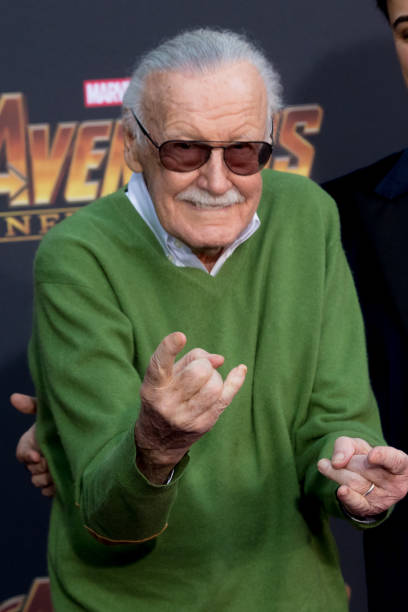Stan Lee‘s death was a shock to true believers everywhere. At the age of 95, his death was imminent but I still felt shocked when I heard the news. Unlike other celebrity deaths, Stan Lee’s felt like the loss of a friend. There are few creators that catch the imagination of the whole world; I’d place Stan Lee right next to Walt Disney in this discussion. Stan Lee told us amazing stories of heroes who were just like normal people, and that anyone at any time can be a hero.
Stan Lee’s Legacy is a True Marvel
Along with legendary artists such as Jack Kirby, Steve Ditko, and John Romita Sr., Stan Lee created some of the most iconic characters in popular culture. In response to the DC Comic’s superhero revival in the 1950’s, Stan Lee was given the green light to create a superhero team that could rival the Justice League of America. At the advice of Joan Lee, his wife of 69 years, Stan Lee created the Fantastic Four and the superhero landscape changed forever.
Up until this point, the superhero archetype was an idealized version of humanity. They were perfect with no real points of conflict. Superman was literally perfect in every way; Batman’s will, intellect, and wealth allowed him to be the peak of human perfection. But Lee’s introduction of the first family of Marvel, the Fantastic Four, showed us that heroes were allowed to worry about issues that people faced every day. Aside from intergalactic threats, the Fantastic Four struggled with issues in marriage, pride, and vanity. From there, Lee introduced the world to heroes such as Spider-Man, the X-Men, the Incredible Hulk, Iron Man, Doctor Strange, Black Panther, Daredevil, and Thor. Despite the incredible, superhuman abilities these characters possessed, these heroes were relatable because of the real issues they faced.
Anyone Can be a Hero
Spider-Man is Stan Lee’s most iconic creation. Unlike other heroes, Spider-Man was not gifted with being perfect. Yes, he is a genius and a spider bite that caused his mutation made him amazing, but Spider-Man is also relatable. Lee shunned the idea that heroes had to have it all. Peter Parker, despite his abilities, faced everyday issues such as relationship problems, personal loss, paying bills, and maintaining a job. These aren’t problems that Superman faced, these are problems that all of us deal with. Stan Lee intentionally created Spider-Man’s costume to hide any indication of his identity because he wanted everyone to identify with him. Peter Parker is obviously a white male, but in his costume, he could be anyone: a struggling student, a person trying to find balance in their life, a person who loves their city. These are issues that transcend age, gender, race, class, and religion, and what truly make Spider-Man great. These stories paved the way for anyone to be a hero, including the future Spider-Man in Miles Morales, an Afro-Hispanic teenager.
Black Panther, the protector of the African kingdom of Wakanda, was the first African-American superhero in the mainstream, but he also created Sam Wilson, the Falcon, who is considered to be the first African-American superhero. Daredevil was a poor, blind, Catholic who struggled with his faith and disability. Dr. Bruce Banner has to control his anger or else he becomes the Incredible Hulk, a character who’s rage leaves him misunderstood. The X-Men and the Inhumans, cornerstones of the Marvel Universe, are groups shunned by the rest of humanity. Stan Lee didn’t seek to tell banal stories of heroes beating bad guys but instead sought to tell stories of flawed humans with incredible powers who overcame incredible conflict in hopes of inspiring people.
Real Heroes, Real Problems
In his books, Stan Lee included a monthly segment aptly titled “Stan’s Soapbox.” This segment didn’t just promote the next storyline but also highlighted issues that Americans faced, such as poverty, intolerance, and other social issues. After the assassination of Martin Luther King Jr., Lee wrote in his editorial: “The bigot is an unreasoning hater – one who hates blindly, fanatically, indiscriminately. If his hang-up is black men, he hates ALL black men. If a redhead once offended him, he hates ALL redheads. If some foreigner beat him to a job, he hates ALL foreigners. Although anyone has the right to dislike another individual, it’s totally irrationally, patently insane to condemn an entire race – to despise an entire nation – to vilify an entire religion.”
Stan Lee’s focus on a diverse group of characters wasn’t an accident. His stories tackled topical issues of his time. For example, the X-Men weren’t just misfits with powers. These heroes were actively shunned by the general population as freaks, faced genocide, and fought against intolerance. Of course, these stories were inspired by the civil rights movement and the characters fought against intolerance alongside costumed supervillains. Even Marvel’s villains had redeeming qualities. Magneto, one of Marvel’s iconic villains, was a product of humanity’s hatred of the other. As a Holocaust survivor and mutant, Magneto sought to punish humanity for their intolerance, though the X-Men fought against this message of hate with a message of love and inclusion. Spider-Woman, She-Hulk, Jean Grey, and Storm constantly battled with issues of gender inequality and demonstrated that women were just as heroic as their male counterparts.
Of course, Stan Lee was a businessman and wanted to sell his stories, but his ability to weave real issues with superheroes ultimately showed us that heroes can be more than flashy costumes and cheesy quips.
Last Word on the Legacy of Stan Lee
Through any medium, Stan Lee’s imagination has embedded itself into the global consciousness. As a child, Stan Lee dreamed of writing the next “Great American Novel.” Ultimately, his imagination created something, in my opinion, greater than that. Excelsior!
Main Image Credit:

